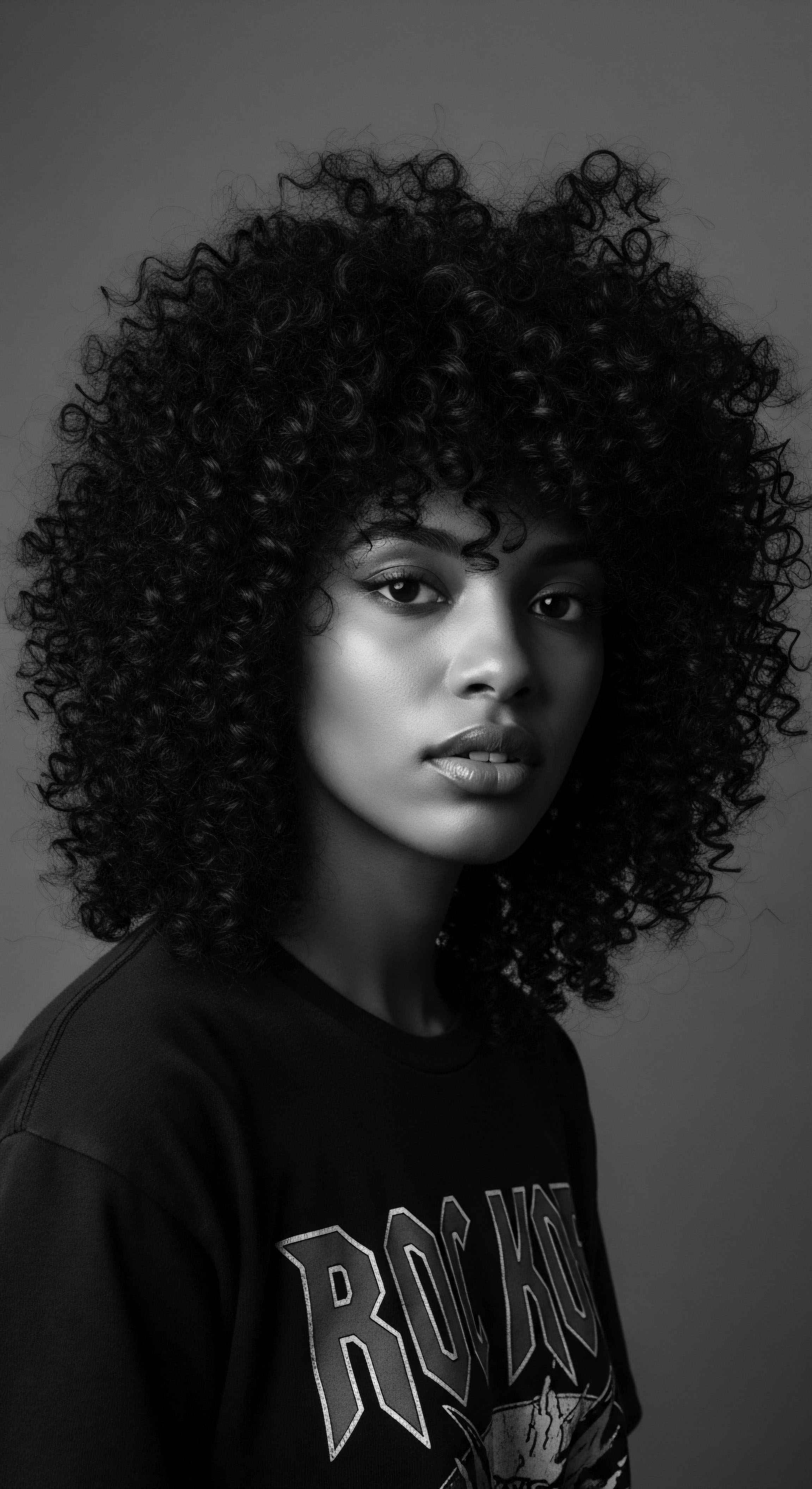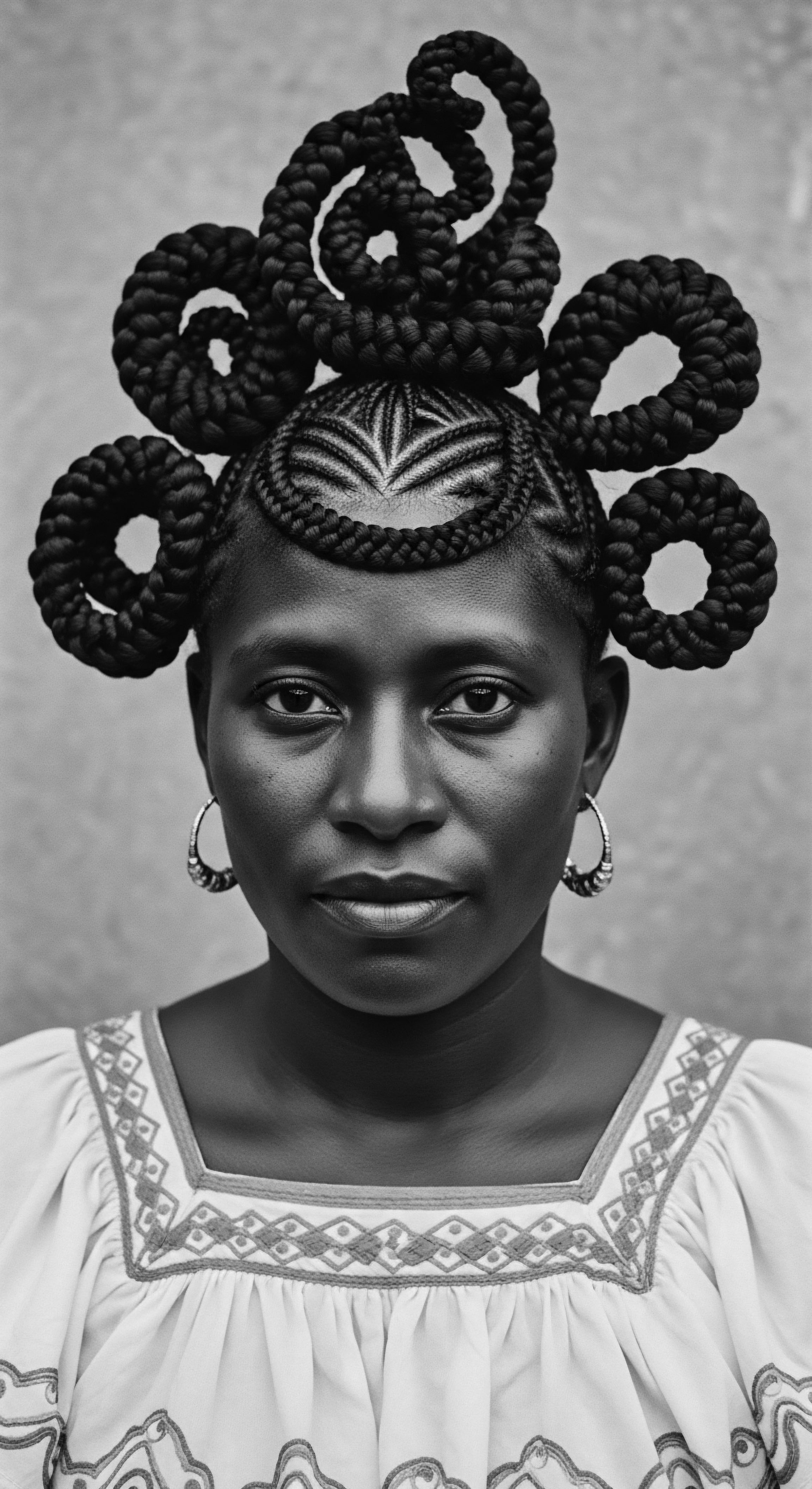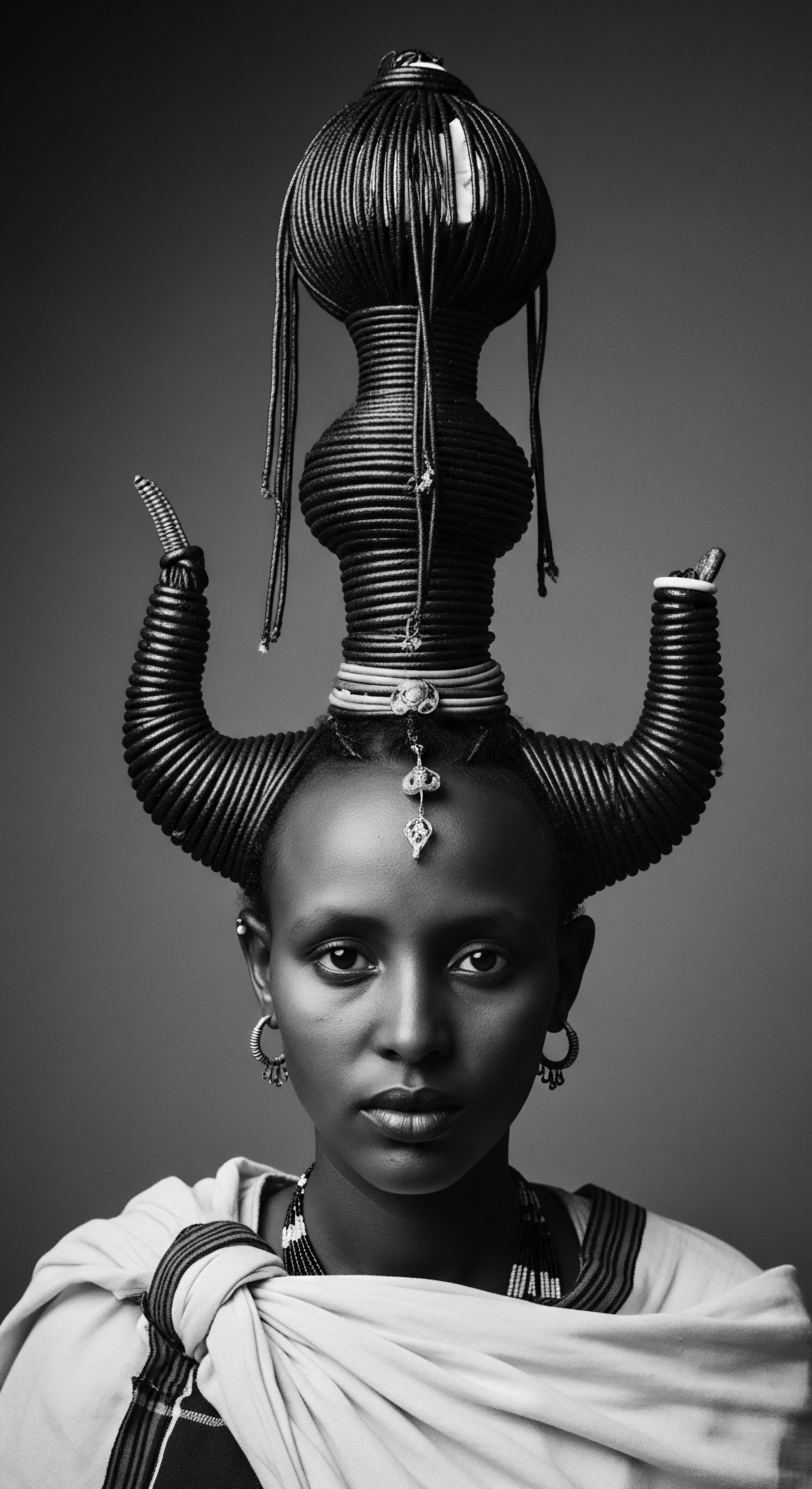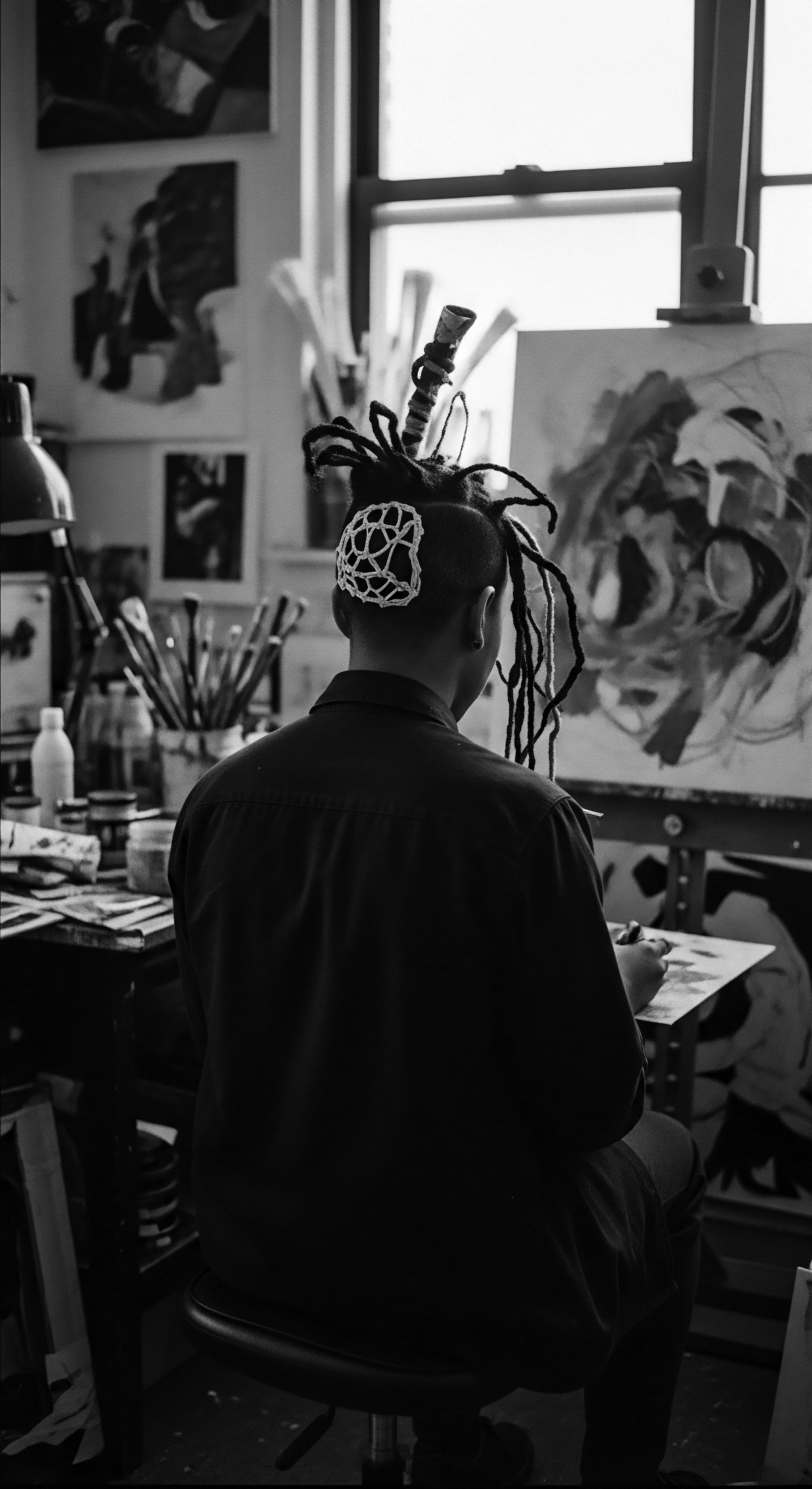
Roots
The stories whispered by each curl and coil, by every braid and twist, are not merely tales of aesthetic choice. They are echoes from an ancient source, resounding with the collective memory of ancestry, identity, and shared experiences. For those whose lineage traces through the vibrant lands of Africa and across the vast ocean to the diaspora, textured hair is far more than biology; it is a living archive, a sacred trust handed down through generations.
These strands hold the history of resilience, the legacy of ingenuity, and the spirit of a people. Understanding the historical cultural significance of textured hair rituals means opening oneself to this profound connection, seeing the hair not just as keratin and protein, but as a bridge to a heritage that speaks volumes without a single uttered word.

Hair Anatomy And Ancient Perspectives
Textured hair, particularly Afro-textured hair, stands apart in its unique physiological attributes. Its characteristic tight curls and spiral shape give it a dense appearance. This distinct structure, often described as highly coiled, is an evolutionary adaptation.
Early hominids living in intensely sunny African climates developed this hair to protect their scalps from the sun’s potent ultraviolet radiation and to provide air circulation, keeping the head cool. Such natural defenses underscore a fundamental, biological heritage that literally protected life from its origins.
The cylindrical shape of the hair follicle determines curl pattern; a more circular follicle tends to yield straighter hair, while a more oval, flatter follicle produces the tighter curls and kinks seen in textured hair. The helical path these strands take as they grow from the scalp means natural oils, known as sebum, do not easily travel down the hair shaft, contributing to its tendency for dryness and brittleness. This inherent dryness historically informed many of the traditional care practices, compelling communities to seek out natural moisturizers and protective styles long before modern science understood the underlying biology.
Textured hair holds ancient biological wisdom, its structure shaped by the very sun it once shielded, guiding ancestral care practices.

Language and Classification Through Time
The language used to describe textured hair has shifted over centuries, at times reflecting cultural reverence and at other times embodying societal biases. Historically, terms like ‘woolly’ or ‘kinky’ were sometimes used in derogatory ways, particularly in the 1800s, to justify racial hierarchies. Yet, within African societies, the lexicon for hair was rich and specific, often tied to social roles, spiritual beliefs, and community standing.
- Ulotrichous ❉ A scientific term that refers to ‘curly-haired’ individuals, rooted in Ancient Greek for ‘crisp’ or ‘curly’.
- Irun Dídí ❉ A Yoruba term for cornrows, or braided hair, signaling a specific cultural practice.
- Departs ❉ A braided hairstyle in Colombian communities, meaning “to depart,” utilized to convey escape plans.
Modern classification systems, such as the Andre Walker Hair Typing System, categorize hair from Type 1 (straight) to Type 4 (kinky or coily), with subcategories (e.g. 4A-4C) indicating degrees of curl tightness. While these systems offer a practical shorthand for care, they stand as a recent development when compared to the nuanced, non-verbal classifications that existed in traditional African societies where a hairstyle could immediately communicate one’s tribe, marital status, age, or wealth.
| Historical Context Hair as a social security number, conveying tribe, marital status, and age. |
| Modern Understanding Andre Walker Hair Typing System (Type 1-4) for curl pattern and care. |
| Historical Context Sacred connection to spirits and gods. |
| Modern Understanding Focus on structural properties ❉ keratin, cortex, melanin, sebum, cuticle. |
| Historical Context Hairstyles indicating specific life stages or community rank. |
| Modern Understanding Scientific explanations for dryness (sebum not reaching ends easily). |
| Historical Context The evolving language of hair reflects its enduring significance, from ancient communal markers to contemporary scientific classifications, always connected to a deep heritage. |

Ritual
The practices surrounding textured hair are not merely routines; they are rituals, steeped in generational memory and cultural resonance. These acts of care and adornment connect us to a continuous lineage, a living tradition that speaks of identity, community, and resistance. From the hands that once braided maps of freedom to the gentle touch of a loved one applying ancestral oils, each step in the hair ritual is a whisper of history.

Styling as Cultural Communication
In pre-colonial African societies, hair styling was a sophisticated form of non-verbal communication. Hairstyles acted as visual indicators, signaling everything from a person’s tribe, age, marital status, and social standing to their religious beliefs and readiness for war. For instance, the Yoruba people created a vast array of elaborate styles, each conveying a specific life stage or social role, such as the Sùkú style, a raised, basket-like shape, often worn by young women and brides during significant ceremonies. Conversely, the Ìpàkó-Elédè , or “pork head,” a style with hair braided backwards from the front, conveyed youth and vitality, often seen on young girls.
The act of styling was often communal, fostering social bonds and acting as a means to transmit cultural traditions from one generation to the next. This shared experience was a profound aspect of communal life, creating connections that transcended spoken words.

Protective Styling And Ancestral Roots
The art of protective styling, so central to textured hair care today, possesses deep ancestral roots. Styles like braids, twists, and locs were not only aesthetic choices but also practical methods for managing hair and symbolizing identity.
During the transatlantic slave trade, when individuals were stripped of their dignity and identity, hair rituals became a powerful form of resistance and cultural preservation. Slave traders often shaved the heads of their captives to erase their connection to African roots, a dehumanizing act. Yet, enslaved Africans adapted. They continued to style their hair, often in secret, using intricate patterns not just for cultural continuity but also to communicate messages and escape routes.
Hair styling, born of necessity and artistry, served as an unbreakable link to heritage amidst the profound ruptures of history.
A powerful instance of this hidden language occurred when enslaved Mende women from Sierra Leone braided maps into their cornrows, detailing escape paths from plantations. These patterns, sometimes resembling worms to indicate rivers or Bantu knots to signify mountains, were clandestine messages, a testament to the ingenious ways heritage persisted against oppression. The practice of braiding rice seeds into hair, particularly by West African rice farmers, served a dual purpose ❉ a means of survival for themselves and their culture in new lands.

Tools, Adornments, and Transformations
The tools and adornments used in textured hair rituals carry their own histories. Combs, often crafted from wood, bone, or tortoise shell, were sometimes intricately carved with animal or human forms, reflecting the artistry within communities. Natural oils and butters, such as shea butter, coconut oil, and animal fats, were used for moisture and protection. These natural ingredients, sourced directly from the land, underscore a holistic approach to hair care that existed long before modern cosmetic science.
In ancient Egypt, hair care held immense significance, symbolizing status, religion, and purity. The elite wore elaborate wigs, sometimes weighing up to 3 kilograms, signaling wealth and prestige. Priests and priestesses often shaved their heads as an act of spiritual purification before approaching the divine. Even today, the use of hair accessories like bonnets connects to historical practices of protecting and preserving hair, ensuring its health and longevity.

Relay
The living heritage of textured hair rituals extends beyond historical practices, flowing into contemporary care philosophies and shaping identities in the present. This enduring legacy, passed through generations, demonstrates a deep, interconnected web of ancestral wisdom, scientific understanding, and profound cultural meaning. The significance of these rituals is not static; it is a relay race across time, each generation carrying the torch of tradition while adapting it to new realities.

Holistic Care And Ancestral Wisdom
Ancient African societies viewed hair care as an integral aspect of overall wellbeing, interwoven with spiritual and communal life. This approach aligns with modern holistic wellness, where physical health intertwines with mental and spiritual balance. For example, traditional African shampoos were often multi-purpose bars, and conditioning practices utilized homemade blends of oils, butters, milks, powders, and resins for growth, strength, and curl definition. This ancestral knowledge, developed over millennia, often mirrors what contemporary hair science now affirms about the needs of textured hair.
The use of indigenous ingredients such as Shea butter , revered as “The Sacred Tree of the Savannah,” provided deep moisturizing properties. Marula oil , a liquid gold from indigenous African trees, offered nourishment. Rhassoul clay from Morocco served as a gentle cleanser, removing impurities without stripping beneficial natural properties. These practices attest to a sophisticated understanding of botanical properties and their application to hair health.

Nighttime Sanctuary And Bonnet Wisdom
The wisdom of protecting textured hair during rest is a tradition that spans generations. Nighttime hair rituals, particularly the use of head coverings, are directly tied to preserving moisture, preventing breakage, and maintaining styles. While the term “bonnet” may seem contemporary, the concept of covering and safeguarding hair during sleep or for preservation has deep historical precedence across African and diasporic communities. This practice speaks to a reverence for the hair as a vital part of self, deserving of careful preservation.
The historical basis for head coverings stretches back to practical needs and cultural norms. Beyond practicalities, headwraps and coverings often held symbolic meaning, denoting marital status, social standing, or religious adherence in various African societies. In the Americas, laws like the Tignon Laws of 1786 in New Orleans attempted to suppress free women of color by forcing them to cover their hair.
Yet, these women transformed the imposed headscarves into vibrant expressions of autonomy, wearing ornate designs that asserted their creativity and spirit. This act of defiance transformed a tool of oppression into a symbol of identity, a heritage of resistance that continues to resonate.

Hair As A Symbol of Resistance
What deeper meaning does hair hold when it becomes a map to freedom? During the era of enslavement in the Americas, cornrows were not solely a style; they were a means of strategic communication, serving as coded maps for escape routes from plantations. Enslaved Africans, denied literacy and other forms of communication, ingeniously utilized their hair to transmit vital information. This quiet act of defiance stands as a powerful example of hair rituals as tools of survival and resistance.
The story of Benkos Biohó, a King in Colombia, provides a compelling illustration. He is credited with conceiving the idea of women creating maps and messages through their cornrows. These intricate braided patterns, known as “departes” (meaning “to depart”), literally charted paths to liberation. A braid shaped like a worm could signify a river, while a Bantu knot might represent a mountain, allowing safe passage through perilous landscapes.
This specific, documented practice offers undeniable evidence of textured hair rituals serving a critical, life-saving function, directly linking hair care to the grand sweep of human history and the relentless pursuit of freedom. (Ibiene, 2022)
In the mid-20th century, the Civil Rights Movement and Black Power Movement sparked a resurgence of natural hairstyles, particularly the afro. This monumental shift was a direct rejection of Eurocentric beauty standards that had long devalued textured hair. The afro became a profound symbol of Black pride , activism, and a powerful political statement, connecting individuals to their African ancestry and affirming a collective identity.
Icons like Angela Davis wore their natural hair as a public declaration, cementing its place in the fight for racial justice. This era underscored how hair, once a site of forced dehumanization through practices like head-shaving by slave traders, reclaimed its place as a symbol of self-expression and liberation.
This continuous narrative, from ancient defiance to modern-day affirmation, confirms that textured hair rituals are more than personal grooming; they are living testimonies to a heritage of strength, ingenuity, and cultural preservation that continues to resonate today.

Reflection
The journey through the historical cultural significance of textured hair rituals reveals an expansive landscape of meaning, a vibrant testament to enduring heritage. We have walked through ancestral practices, observed the silent language of braids, and witnessed the profound power of hair as a symbol of identity and resistance. The ‘Soul of a Strand’ ethos reminds us that each coil, each pattern, each ritual holds a fragment of a larger story—a narrative of resilience, creativity, and profound connection to generations past.
From the very biological adaptations that shaped textured hair for survival on the continent of Africa to the ingenious ways enslaved people encoded maps of freedom within their hairstyles, the heritage is palpable. It is a heritage that speaks not only of what was endured but also of what was celebrated, preserved, and innovated. The simple act of caring for textured hair, whether through traditional methods or modern approaches inspired by ancestral wisdom, becomes a conscious act of honoring this living legacy.
It is a conversation with history, a nod to the elders, and a promise to future generations. The rich traditions surrounding textured hair are not relics of the past; they are dynamic forces, shaping perceptions of beauty, identity, and belonging in the present, while guiding paths forward.

References
- Abimbola, W. (1976). Ifa ❉ An Exposition of Ifa Literary Corpus. Ibadan, Nigeria ❉ Oxford University Press.
- Byrd, A. D. & Tharps, L. (2009). Hair Story ❉ Untangling the Roots of Black Hair in America. St. Martin’s Griffin.
- Clark, S. (2018). Tatter, Bristle, and Mend. National Museum of Women in the Arts.
- Dove, A. & Powers, L. (2018). Black women’s hair care practices ❉ A systematic review. Journal of Cosmetic Dermatology, 17(5), 659-667.
- Holloway, J. E. (2013). Africanisms in the American Culture. Indiana University Press.
- Idowu, E. B. (1995). Olódùmarè ❉ God in Yoruba Belief. Longman.
- Johnson, A. E. & Bankhead, T. (2014). From nappy to happy ❉ The cultural politics of black hair. The Journal of Popular Culture, 47(4), 668-685.
- Loussouarn, G. et al. (2007). In vitro study of curly hair ❉ geometry, physical properties, and treatment. International Journal of Cosmetic Science, 29(4), 273-282.
- Marshall, A. (2020). Hair in Ancient Egypt. Oxbow Books.
- Omotos, A. (2018). Hair and African Spirituality. Journal of Pan African Studies, 11(3), 104-118.
- Thompson, A. (2019). Hair Love ❉ A Celebration of Black Hair. Penguin Random House.
- Yerima, K. (2017). The Black aesthetic ❉ Beyond identity politics. Journal of Black Studies, 48(7), 648-662.
